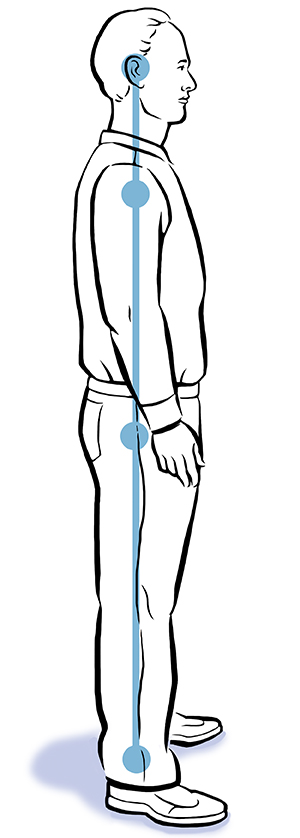Protecting your neck from injuries and pain involves practicing good posture and body mechanics. This may mean correcting bad habits you have related to the way you hold and move your body. The tips below can help you improve your posture and body mechanics.
What is posture and why does it matter?
Posture is the way you hold your body. For many people, this means hunching over, thrusting the chin forward, and slouching the shoulders. But this kind of poor posture keeps muscles from correctly supporting the neck and puts stress on muscles, disks, ligaments, and joints in your neck. As a result, injury and pain can happen.
How is your posture?
Use a full-length mirror to check your posture. To begin, stand normally. Then slowly back up against a wall. Is there space between your head and the wall? Do you slouch your shoulders? Is your chin pointing up or down? All these can lead to neck tension and pain.
Improving your posture
Follow these steps to improve your posture:
-
Pull your shoulders back.
-
Think of the ears, shoulders, and hips as a series of dots. Now, adjust your body to connect the dots in a straight line.
-
Keep your chin level.
What are body mechanics and why do they matter?
The way you move and position your body during daily activities is called body mechanics. Good body mechanics help protect the neck. This means learning the right ways to stand, sit, and even sleep. So, do what’s best for your neck and practice good body mechanics.
Standing
To protect your neck while standing:
-
Carry objects close to your body.
-
Keep your ears and shoulders in a line while standing or walking.
-
To lower yourself, bend at the knees with a straight back. Do this instead of looking down and reaching for objects.
-
Work at eye level. Don’t reach above your head or tilt your head back.
Sitting
To protect your neck while sitting:
-
Set up your workstation so your monitor is at eye level. Also use a document holder when viewing papers or books.
-
Keep your knees at or slightly below the level of your hips.
-
Sit up straight, with feet flat on the floor. If your feet don’t touch the floor, use a footrest.
-
Don't sit or drive for long periods. Take breaks often.
Sleeping
To protect your neck while sleeping:
-
Sleep on your back with a pillow under your knees or on your side with a pillow between bent knees. This helps align the spine.
-
Don't use pillows that are too high or too low. Instead, use a neck roll or pillow under your neck while you sleep to keep the neck straight.
-
Sleep on a mattress that supports you.
Using mobile devices
To protect your neck while using mobile devices:
-
Sit up when texting or using your device.
-
Keep your device at chest or eye level. This helps reduce stress on your neck and back.


